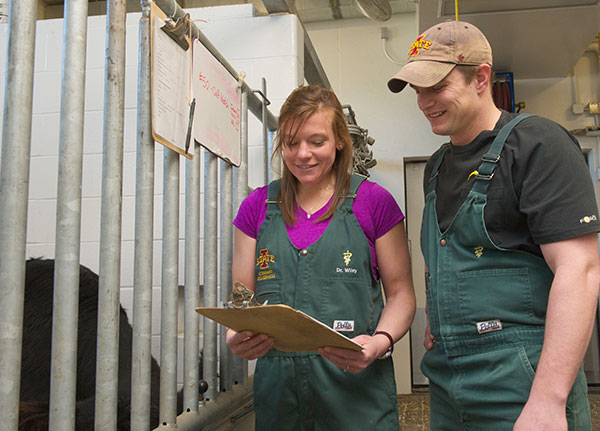
Bovine maternity ward busy with special deliveries
Bone-chilling cold, snowstorms and ice … it’s calving season in the Midwest. For the veterinary reproduction team at ISU’s Lloyd Veterinary Medical Center, it means a full house of expectant cows and heifers.
Calving season runs from December to May, but “from late December through February, Mother Nature runs the show,” says Dr. Tyler Dohlman, board-certified theriogenology (reproduction specialist).
It’s tough to fight Mother Nature, but cattle producers like Mark Anderson, have found a way to lessen her bite.
It was the day after Christmas and a snowstorm was expected to hit central Iowa in a couple of days. Anderson had three very pregnant cows, and he didn’t want to take any chances that they would calve during the storm. So he put them in the trailer and drove them to ISU where he could take advantage of the calf-watch program that offers facilities like a maternity ward with 24/7 monitoring, advanced equipment and specialized expertise.
The bovine maternity ward provides a climate-controlled, well-ventilated, comfortable, and safe environment for expectant mothers to deliver their newborns. Under the watchful eyes of the veterinary team, every move of these expectant moms-to-be will be monitored until they and their calves go home.
With a passion for pregnant cows and newborn calves, the team is almost fanatical in its attention to detail and protocol, and they leave nothing to chance. “Our goal is getting that calf on the ground and sending two live, healthy animals back home,” Dohlman says.
Producers use the program for a variety of reasons. Sometimes, a cow may have a pre-existing medical condition that poses a risk to the cow or the calf, or both. Many times, it’s the harsh winter weather that pushes the occupancy rate of the ward where the cows can calve in a controlled environment with constant monitoring.
Regardless of the reason for their arrival, expectant moms receive a thorough exam so the team can plan and decisions can be made before the critical delivery process starts. “We also have a list of questions for the owner, so we aren’t calling them at 2 am to make a decision,” Dohlman said.
The cows are checked every hour, and once contractions start and the amniotic sac breaks, they are checked every 20 minutes. And, the clock starts. Dohlman explains that four hours is the time limit for progress for heifers (cows that haven’t had a calf). “We want to make sure that progress is being made. If there’s no progress, we’ll watch more frequently to check that everything is still okay and prepare to assist if needed. The hardest thing for a veterinarian is to do nothing, but it’s best for the cow and the calf if the cow can deliver on her own.”
The calf-watch program performs very few caesarian sections. Dohlman explains that getting the cows in the program early allows the team to assist earlier, and manage any problems that may occur during the delivery. “When we have the option to intervene early, we have a much better outcome.”
Having cows deliver in a controlled environment is not only good for the cows, but, more importantly, good for the calves. “Calves are born wet and with limited brown fat to keep them warm,” Dohlman explains. “To thermo-regulate themselves, they need to get up and nurse to get colostrum (first milk).”
Those first few hours of neonatal care are vital to a healthy calf. The veterinary team gives the calf an extra dose of tender loving care, making sure it bonds with its mom and is nursing on its own. “We make sure the calf care is comprehensive and the best that we can do,” Dohlman said. I always ask myself, ‘If this were my animal, how would I want it cared for.’”
Successful calving is one of the reasons Anderson continues to bring his cows to ISU. “When the calf doesn’t have to struggle to stay warm and nurse, it makes all the difference in how quickly they thrive,” he said.
Anderson has brought many of his pregnant cows to ISU over the years, and has a lot of confidence in the reproductive team. “Dr. Dohlman lets the cow take her time. He has a lot of patience and always remains calm, never in a rush. He communicates with us during the entire process, letting us know when the calf was born, its gender and weight, and how it’s doing.”
“The best part of the job is working with clients, getting to know them and how I can help them be successful,” Dohlman said.
“Our producers are entrusting the care of their cow and calf to us, and they want the best quality of life for the calf from the get-go,” Dohlman said. “Seeing a calf nurse and watching it run around in the stall near its mom makes my day.”
Contact: Tracy Ann Raef, Iowa State University College of Veterinary Medicine, 515 294.4602
December 2015
